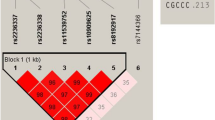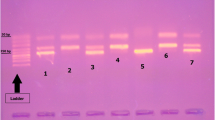Abstract
Vitiligo is a pigmentary skin disorder characterized by the chronic and progressive loss of melanocytes. Although the etiology of vitiligo is still unknown, several theories have been proposed to explain the pathogenesis of vitiligo including autoimmune, neural, self-destruction, oxidative stress, and genetic theories. Human leukocyte antigen (HLA)-G is a nonclassic, major histocompatibility complex class I molecule that plays an important role in suppression of the immune response. Several recent studies have provided evidence that a 14 bp insertion (INS)/deletion (DEL) polymorphism in the HLA-G gene might be associated with autoimmune disease. Our aim in this study was to determine whether the 14 bp INS/DEL polymorphism in the HLA-G gene contributes to the risk of developing non-segmental vitiligo (NSV) in the Korean population. We conducted a case–control association study of 192 NSV patients and 491 matched, unaffected controls. The HLA-G 14bp INS/DEL polymorphism was analyzed by gene scan after amplification using the polymerase chain reaction. Genotype frequencies for the 14bpINS/DEL were different between the vitiligo group and Korean control group. The proportion of subjects with a homozygote 14bpINS/14bpINS genotype was significantly higher in the vitiligo group compared with the control group (7.1 vs. 3.5 %, OR 2.25, 95 % CI 1.06–4.76, p = 0.039 in the recessive model). Our results suggest that the HLA-G 14bpINS/DEL polymorphism is associated with the development of NSV in the Korean population.

Similar content being viewed by others
References
Aractingi S, Briand N, Le Danff C, Viguier M, Bachelez H, Michel L, Dubertret L, Carosella ED (2001) HLA-G and NK receptor are expressed in psoriatic skin: a possible pathway for regulating infiltrating T cells? Am J Pathol 159:71–77
Crisa L, McMaster MT, Ishii JF, Fisher SJ, Salomon DR (1997) Identification of a thymic epithelial cell subset sharing expression of the class Ib HLA-G molecule with fetal trophoblasts. J Exp Med 186:289–298
Dahl M, Hviid TVF (2012) Human leucocyte antigen class Ib molecules in pregnancy success and early pregnancy loss. Hum Reprod Update 18:92–109
Dejaco C, Duftner C, Grubeck-Loebenstein B, Schermer M (2006) Imbalance of regulatory T cells in human autoimmune diseases. Immunology 117:289–300
Du L, Xiao X, Wang C, Zhang X, Zheng N, Wang L, Zhang X, Li W, Wang S, Dong Z (2011) Human leukocyte antigen-G is closely associated with tumor immune escape in gastric cancer by increasing local regulatory T cells. Cancer Sci 102:1272–1280
Fournel S, Aguerre-Girr M, Huc X, Lenfant F, Alam A, Toubert A, Bensussan A, Le Bouteiller P (2000) Cutting edge: soluble HLA-G1 triggers CD95/CD95 ligand-mediated apoptosis in activated CD8+ cells by interacting with CD8. J Immunol 164:6100–6104
Gazit E, Slomov Y, Goldberg I, Brenner S, Loewenthal R (2004) HLA-G is associated with pemphigus vulgaris in Jewish patients. Hum Immunol 65:39–46
Hann SK, Lee HJ (1996) Segmental vitiligo: clinical findings in 208 patients. J Am Acad Dermatol 35:671–674
Harrison GA, Humphrey KE, Jakobsen IB, Cooper DW (1993) A 14 bp deletion polymorphism in the HLA-G gene. Hum Mol Genet 2:2200
Hviid TV, Hylenius S, Rorbye C, Nielsen LG (2003) HLA-G allelic variants are associated with differences in the HLA-G isoform profile and HLA-G mRNA levels. Immunogenetics 55:63–79
Hviid TV, Rizzo R, Christiansen OB, Melchiorri L, Lindhard A, Baricordi OR (2004) HLA-G and IL-10 in serum in relation to HLA-G genotype and polymorphisms. Immunogenetics 56:135–141
Ishitani A, Geraghty D (1992) Alternative splicing of HLA-G transcripts yields proteins with primary structures resembling both Class I and Class II antigens. Proc Natl Acad Sci USA 89:3947–3951
Jalel A, Ridha A, Laurent D, Philippe M, Hamdaoui MH (2010) Impact of HLA-G in the outcome of vitiligo in Tunisian patients. Indian J Dermatol 55:25–28
Kapasi K, Albert SE, Yie S, Zavazava N, Librach CL (2000) HLA-G has a concentration dependent effect on the generation of an allo-CTL response. Immunology 101:191–200
Kim SK, Hong MS, Shin MK, Uhm YK, Chung JH, Lee MH (2011) Promoter polymorphisms of the HLA-G gene, but not the HLA-E and HLA-F genes, is associated with non-segmental vitiligo patients in the Korean population. Arch Dermatol Res 303:679–684
Kovacs SO (1998) Vitiligo. J Am Acad Dermatol 38:647–666
Kovats S, Main EK, Librach C, Stubblebine M, Fisher SJ, DeMars R (1990) A class I antigen, HLA-G, expressed in human trophoblasts. Science 248:220–223
Le Poole IC, van den Wijngaard R, Westerhof W, Das PK (1996) Presence of T cells and macrophages in inflammatory vitiligo skin parallels melanocyte disappearance. Am J Pathol 148:1219–1228
Liang S, Ristich V, Arase H, Dausset J, Carosella ED, Horuzsko A (2008) Modulation of dendritic cell differentiation by HLA-G and ILT4 requires the IL-6-STAT3 signaling pathway. Proc Natl Acad Sci USA 105:8357–8362
Marchal-Bras-Goncalves R, Rouas-Freiss N, Connan F, Choppin J, Dausset J (2001) A soluble HLA-G protein that inhibits natural killer cellmediated cytotoxicity. Transplant Proc 33:2355–2359
Moreau P, Adrian-Cabestre F, Menier C, Guiard V, Gourand L, Dausset J, Carosella ED, Paul P (1999) IL10 selectively induces HLA-G expression in human trophoblasts and monocytes. Int Immunol 11:803–811
Oyarbide-Valencia K, van den Boorn JG, Denman CJ, Li M, Carlson JM, Hernandez C, Nishimura MI, Das PK, Luiten RM, Le Poole IC (2006) Therapeutic implications of autoimmune vitiligo T cells. Autoimmun Rev 5:486–492
Rebmann V, van der Ven K, Passler M, Pfeiffer K, Krebs D, Grosse-Wilde H (2001) Association of soluble HLA-G plasma levels with HLA-G alleles. Tissue Antigens 57:15–21
Rizzo R, Farina I, Bortolotti D, Galuppi E, Rotola A, Melchiorri L, Ciancio G, Di Luca D, Govoni M (2013) HLA-G may predict the disease course in patients with early rheumatoid arthritis. Hum Immunol 74:425–432
Sole X, Guino E, Valls J, Iniesta R, Moreno V (2006) SNPStats: a web tool for the analysis of association studies. Bioinformatics 22:1928–1929
Spritz RA (2008) The genetics of generalized vitiligo. Curr Dir Autoimmun 10:244–257
Taïeb A, Picardo M (2007) The definition and assessment of vitiligo: a consensus report of the Vitiligo European Task Force. Pigment Cell Res 20:27–35
Veit TD, Cordero EA, Mucenic T, Monticielo OA, Brenol JC, Xavier RM, Delgado-Cañedo A, Chies JA (2009) Association of the HLA-G 14 bp polymorphism with systemic lupus erythematosus. Lupus 18:424–430
Veit TD, Vianna P, Scheibel I, Brenol CV, Brenol JC, Xavier RM, Delgado-Cañedo A, Gutierrez JE, Brandalize AP, Schuler-Faccini L, Chies JA (2008) Association of the HLA-G 14-bp insertion/deletion polymorphism with juvenile idiopathic arthritis and rheumatoid arthritis. Tissue Antigens 71:440–446
Wiendl H, Behrens L, Maier S, Johnson MA, Weiss EH, Hohlfeld R (2000) Muscle fibers in inflammatory myopathies and cultured myoblasts express the nonclassical major histocompatibility antigen HLA-G. Ann Neurol 48:679–684
Wiendl H, Feger U, Mittelbronn M, Jack C, Schreiner B, Stadelmann C, Antel J, Brueck W, Meyermann R, Bar-Or A, Kieseier BC, Weller M (2005) Expression of the immune-tolerogenic major histocompatibility molecule HLA-G in multiple sclerosis: implications for CNS immunity. Brain 128:2689–2704
Acknowledgments
This work was supported by a grant from the Kyung Hee University in 2011. (KHU-20110893).
Conflict of interest
The authors have no conflict of interest to declare.
Author information
Authors and Affiliations
Corresponding author
Additional information
K.-H. Jeong and S.-K. Kim contributed equally.
Rights and permissions
About this article
Cite this article
Jeong, KH., Kim, SK., Kang, BK. et al. Association between an HLA-G 14 bp insertion/deletion polymorphism and non-segmental vitiligo in the Korean population. Arch Dermatol Res 306, 577–582 (2014). https://doi.org/10.1007/s00403-014-1459-5
Received:
Revised:
Accepted:
Published:
Issue Date:
DOI: https://doi.org/10.1007/s00403-014-1459-5




